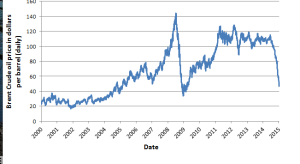Oil Prices Continue to Fall
8th December 2015
If You Want to Understand Markets, Look at Oil

Oil prices have fallen dramatically since August 2014. Saudi Arabia has refused to police the market by cutting production in the face of OPEC members’ ill-discipline in exceeding quotas.
The oil price continues to fall: today (December 8th 2015) Brent crude fell to $42 a barrel. In 2014 the Bloomberg survey of oil analysts predicted oil prices of $82 a barrel – they are wrong by $40 – a huge error if you’re betting forward on future oil prices. As I commented in the 2015 economic survey, oil makes a fascinating market study as it is a cartel – but a cartel that is disintegrating. There are five reasons why.
1. Iran comes in from the cold. Up to 2015, Iran had been subject to sanctions which limited its ability to export oil. But following the Syrian conflict, Iran is coming out of the cold: Shiite Iran is a new partner in the war against Sunni ISIS. Indeed, Iranian militias are one of the two really effective fighting forces in Iraq (the Kurds are the other). Sanctions have been lifted and Iranian oil is back on stream.
2. Saudi Arabia is in a catch-22. Oil prices, have fallen from $115 per barrel in June 2014. Saudi Arabia has already spent $65 billion of its financial reserves since then, and plans to raise an additional $27 billion by issuing bonds by the end of 2015 to compensate for lavish government spending. But it is not prepared to cut its production to stabilise prices.
3. OPEC ill-discipline.At the latest OPEC meeting this week, the 12 countries (which include Iran) failed to agree either an overall production target or individual targets. This places Saudi Arabia in a difficult situation: it cannot cut its own production without affecting its oil revenues, and it cannot cause the price to rise without cutting production. The cartel has effectively disintegrated, for cartels can only maintain prices by maintaining production discipline.
4. The Saudi gamble failed: the Saudis wanted to punish the shale oil and gas industry in the USA for the huge amount of oil they’d extracted through fracking – a technique of oil extraction that involves detonating charges deep underground. So in August 2014 the Saudis abandoned any attempt to police the oil market by varying its own production. But US shale oil production has not fallen significantly, despite incurring large losses (it’s relatively expensive to extract at $65 a barrel).
5. The gambling continues. Oil, like any other commodity, suffers speculative pressure as traders ‘bet’ on forward prices. They are all betting on a further fall, and this becomes self-fulfilling. As in any market, never forget the role of expectations which become self-fulfilling as the activity of the speculators creates the very price movement they are expecting.
Goldman Sachs is forecasting oil prices will bottom out at $20 barrel in 2016. Watch this space: the oil saga, like Poldark, has more episodes yet to run.
Peter Baron
Activity:
1. Using supply and demand curves, explain the oil price movement since August 2014.
2. On a separate demand and supply diagram, depict how Saudi Arabia, with 18% of world oil production, polices the market price.

0 Comments